stugray
Oct 14 2012, 02:06 PM
Ok, so I bought the deck height measurement tools from the group buy.
But I cannot figure out exactly how the OP intended to use the middle plate.
I have been trying to measure my deck height accurately for weeks now and I either am not doing it right, or I have a problem.
I have the EMW AA cylinders & KB Hypereutectic pistons - brand new.
I am measuring with no shims under the cyls.
I bolt the holddown tool on two cyls with pistons installed and torque to spec (24 ft-lbs)
I set TDC on the cyl I am about to measure with a mag base & dial indicator using the middle of the piston as reference.
I then set a VERY straight edge across both cylinders and clamp it down.
I then measure the top of the cylinder mating surface down to the very edge of the piston using a dial indicator/depth gauge.
I repeat the measurement at least 5 times and average the results.
I am getting measurements that vary from .022 to .032 and they can vary by up to .0067 across a single piston (front to rear).

(measurements at the same spot are repeateable within less than .001)
When we are trying to get these deck heights to match to within a few thousandths, I cannot see how that can be done when the piston can be off by more than 5 thousandths front to rear.
Does this mean I have bent rods or misaligned wrist pin bushings?
I had the entire rotating assembly balanced, so I would hope they would have caught something bent.
I guess my next steps will be to shuffle the pistons around and see if the measurements follow the pistons.
If they dont, I might need to move rods.
Can all 4 rods be removed & replaced without splitting the case again?
Stu
VaccaRabite
Oct 14 2012, 04:28 PM
Shim the base of the cylinders.
Don't start moving pistons and rods. Move the cylinders out slightly with base shims - some would have come in your rebuild seal kit usually.
Zach
rick 918-S
Oct 14 2012, 05:46 PM
Just a guess but sounds like maybe collapsed registers. If the measurement is off across the piston in the same plane as the wrist pin. Check to see if the block is true across the bores where the cylinders slide in.
Valy
Oct 14 2012, 10:26 PM
Are the rings on?
The pistons will rock a bit in the jugs when the rings are off causing inconsistent measurements.
Also make sure the jugs are fastened well and use a shim under them.
yeahmag
Oct 15 2012, 11:11 AM
Are you using the tool I built?
-Aaron
McMark
Oct 15 2012, 11:36 AM
Did you have the cylinder spigots machined?
stugray
Oct 15 2012, 01:42 PM
1- Just curious, why would shims make a difference. They cannot make it any flatter.
2 - Aaron, Yes I am using your tool, but I cannot make sense how to use the plate. So currently I am just using the holddown bars.
3 - McMark - what are the cylinder spigots? You mean what everyone else calls registers? No I did not have anything on the case machined.
When I put a VERY straight edge across the tops of the cylinders, I do not see any gaps where the straight edge touches the cylinder mating surfaces. I assume within .001 flat acroos two cyls.
Stu
yeahmag
Oct 15 2012, 02:15 PM
The plate simply sits on top of the cylinders located by the C shaped notches. Do not clamp it. It must be free floating. Use the center "hole" to find TDC. Zero your depth mic on the far side with the slot against the cylinder you are measuring. Drop the depth mic in the center hole and measure. You can now also measure the adjacent cylinder via the "slot" to see if there are any height differences.
r_towle
Oct 15 2012, 03:15 PM
I measure at the side of the piston directly above the piston ring.
Use just the top ring in place.
Pistons rock when you touch them.
rich
yeahmag
Oct 15 2012, 03:24 PM
Rich,
I think you mean above the piston "wrist pin". You get the least "wiggle" there.
VaccaRabite
Oct 15 2012, 03:39 PM
When I did mine I measured from the exact center of the piston to minimize the rocking, and did it w/o any rings on the pistons.
What is your target compression ratio?
Deck height is important because that is one of the variables in your compression ratio. Shims make a difference because that is how you get your deck height the same between all the cylinders. Measuring w/o shims is kind of pointless.
You start with the target deck height to need to get to the ideal compression ratio. Add shims to get that deck height on all 4 corners.
If the .022 to .032 delta is between cylinder of opposite banks, you are probably fine. Once you shim the bases of the cylinders they will be the same. If the .022 to .032 delta is on the same bank (IE - the 1,2 bank or the 3,4 bank) you may have head sealing issues on that side. The cause will be the case registers, which should have been checked while the case was at your machinist. Its one of those things that many machinists don't know to do unless we ask them. The registers on my case had to come down quite a bit to get them even, and were the cause of a head leak which made me tear down the engine for rebuilding in the first place.
Zach
stugray
Oct 15 2012, 03:40 PM
I have all of the rings on and I measure in line with the wrist pins so I should have minimal "wiggle".
Stu
yeahmag
Oct 15 2012, 03:45 PM
Do you understand how to use the tool now? If not PM me and I'll give you my phone number.
r_towle
Oct 15 2012, 04:08 PM
QUOTE(yeahmag @ Oct 15 2012, 05:24 PM)

Rich,
I think you mean above the piston "wrist pin". You get the least "wiggle" there.
yup.
stugray
Oct 15 2012, 09:19 PM
QUOTE
If the .022 to .032 delta is between cylinder of opposite banks, you are probably fine. Once you shim the bases of the cylinders they will be the same.
The .006 difference is across the same piston without moving the crank.
QUOTE
What is your target compression ratio?
10:1
QUOTE
Deck height is important because that is one of the variables in your compression ratio. Shims make a difference because that is how you get your deck height the same between all the cylinders. Measuring w/o shims is kind of pointless.
I understand that.
My very next step was to have the heads machined to increase my CR.
Before I can even determine how much to take off the heads, I need accurate deck heights.
So my initial measurements were to be with no shims.
Then machine heads
Then remeasure everything and pick the shims.
Then I can shim to where I want.
Stu
yeahmag
Oct 16 2012, 10:55 AM
Which direction are you measuring the piston? Across the pin (horizontal) or vertically?
That's a pretty big number for CR. What cam and gas are you planning on using?
You should only shim if you have too little deck height. So I'd suggest a slightly different order:
* Measure deck height.
* Shim if necessary to get safe margins
* CC heads
* Calculate CR
* Fly cut heads to raise CR/Add shims to lower CR.
The only meaningful deck height number is along the wrist pin. Ideally in the center hole.
wndsrfr
Oct 16 2012, 11:31 AM
[quote name='stugray' date='Oct 15 2012, 07:19 PM' post='1753775']
The .006 difference is across the same piston without moving the crank.

I'm going to close my eyes and imagine what would cause this....only picture I can imagine is that one register is lower than the other. The top plate is actually holding the jugs in alignment at the top but if you could get a feeler gauge under the bottom of the cylinders all around you'd find some clearance on one side or another of the cylinder bases. That would yield a cylinder alignment cocked with respect to the perpindicular of the centerline of the crank/rod throws. If this is the case, the high side of adjacent pistons would show up either toward the front or the back of the engine....solution, deck your case!
r_towle
Oct 16 2012, 12:59 PM
If those measurements are at the top of the piston, directly above both sides of the wrist pin then you need to deck your case.
If you are measuring the top and bottom of the piston, those measurement are actually normal due to rocking of the piston.
Rich
stugray
Oct 16 2012, 04:54 PM
QUOTE
That's a pretty big number for CR. What cam and gas are you planning on using?
This is a vintage race engine that is carbed and will race at >5000 ft and run race gas (if required). I have Jakes full race cam package.
QUOTE
If those measurements are at the top of the piston, directly above both sides of the wrist pin then you need to deck your case.
They are measured directly above the ends of the wrist pins.
But when I put a straight edge across the tops of the cylinders they appear to be flat to within .001. To get a tipped piston, I can only imagine a bent rod, or a bad wrist pin bushing. I have a local Porsche expert that told me he has found wrist pin bushings installed incorrectly that would give me this symptom.
Stu
yeahmag
Oct 16 2012, 04:56 PM
Measure using the slot on the inner edge of each cylinder:
)(
Let us know if there is a any measurable difference. Is it only one piston giving you grief? Can you take a picture of how you have the deck height tool set up just to idiot check it?
stugray
Oct 16 2012, 05:18 PM
yeahmag,
I only see the large difference in side-to-side measurements on one cylinder.
The other three only vary by a couple of thousandths.
I just ordered (yesterday) a higher quality depth gauge with a wider base.
I dont even want to mess with 'the mess' until I get the new tool.
I also intend to measure "piston wiggle" at a few different crank positions. This would tell me if the crank is bent.
I have always intended to get nice pictures of your tool in action, but I haven't got good results so far (my fault or bad parts)
Stu
yeahmag
Oct 16 2012, 05:22 PM
That stinks... Sounds like something is messed up.
r_towle
Oct 16 2012, 05:25 PM
Have you tried a simple feeler gauge and a straight edge?
stugray
Oct 16 2012, 10:22 PM
QUOTE
Have you tried a simple feeler gauge and a straight edge?
Yes and it showed a difference from side to side but was not as repeatable as what I am doing now. You can see with your eye that the gap is different.
I repeated the measurements with the cyl @ BDC and I still see a difference of ~.006 from side to side.
I will get the new gauge the end of this week. I will try it all over then. ( and get pics)
Stu
VaccaRabite
Oct 17 2012, 06:42 AM
Please put up some pictures of what you are doing.
Zach
bobhasissues
Oct 17 2012, 08:03 PM
QUOTE
I have Jakes full race cam package.
You have mentioned this cam in several of your threads. Just curious, what is Jake's "full race cam package"? He refers to his cams by number, 9550, 9530, etc..Never heard of his "full race cam".
stugray
Oct 18 2012, 10:24 AM
Bob - I would post a link to Jakes Type-IV store to show you but the site has been down for months.
I have Jake's "Full race Cam". It is the most aggressive cam he has, but I am not sure of the model number. I'll look for the cam card.
When you buy a cam from Jake, you can also buy the "full package" which includes pushrods, rocker shaft parts, and lifters.
Stu
VaccaRabite
Oct 18 2012, 12:00 PM
QUOTE(stugray @ Oct 18 2012, 11:24 AM)

Bob - I would post a link to Jakes Type-IV store to show you but the site has been down for months.
I have Jake's "Full race Cam". It is the most aggressive cam he has, but I am not sure of the model number. I'll look for the cam card.
When you buy a cam from Jake, you can also buy the "full package" which includes pushrods, rocker shaft parts, and lifters.
Stu
Unless he has changed things up again you can no longer buy just a cam from his shop. You have to get the full package.
Though last I heard he was discontinuing his cam kit program completely.
You can get the valve train upgrades (minus the cam, lifters and cam gear) from European Motor Works, and they are 100% worth it.
Zach
stugray
Oct 20 2012, 08:17 PM
The cam is a: "Super 9700 Cam Kit", included a Type-IV store part # 9700 and all the other goodies.
I get a new depth gauge on monday.
Measuring with yeahmag's plate was more consistent but still shows a ??
I'll get pics as i do it with the right tools.
If i still see a problem, I will move a rod from 4 to 3 and remeasure.
Stu
stugray
Oct 22 2012, 11:16 PM
Ok, got the new tools to do this right, and the results are the same:
Here is a picture of the two "rails" that hold down the cylinders (this is yeahmag's tool with AL spacers replaced with steel pipe).
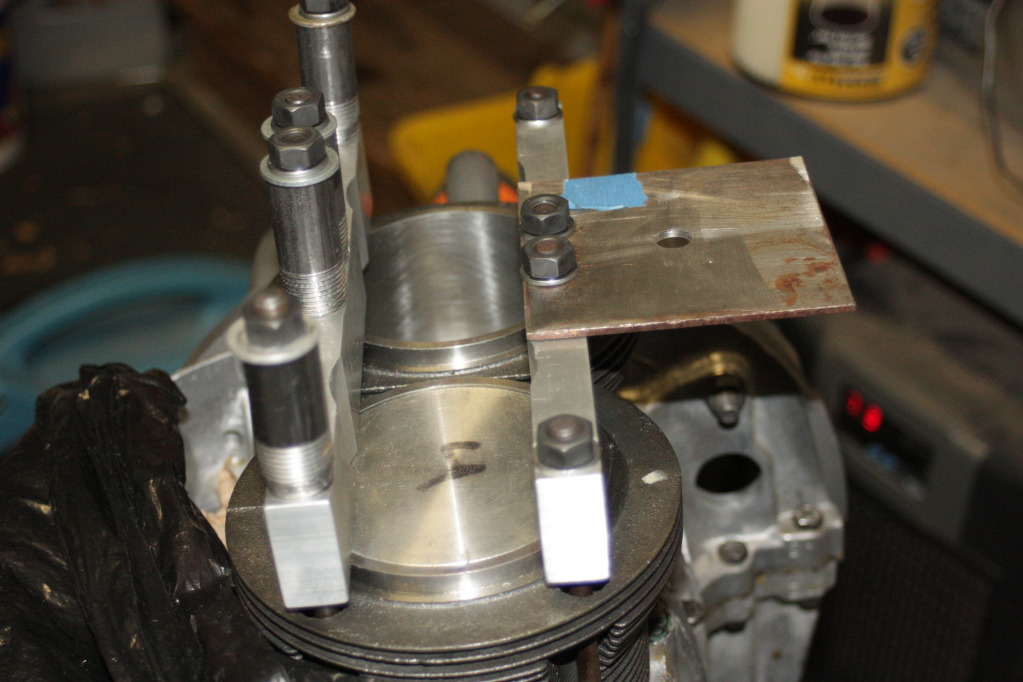
Here is a pic of the flat plate that allows you to measure the edge of the cylinder, the edge of the piston (both sides and center)
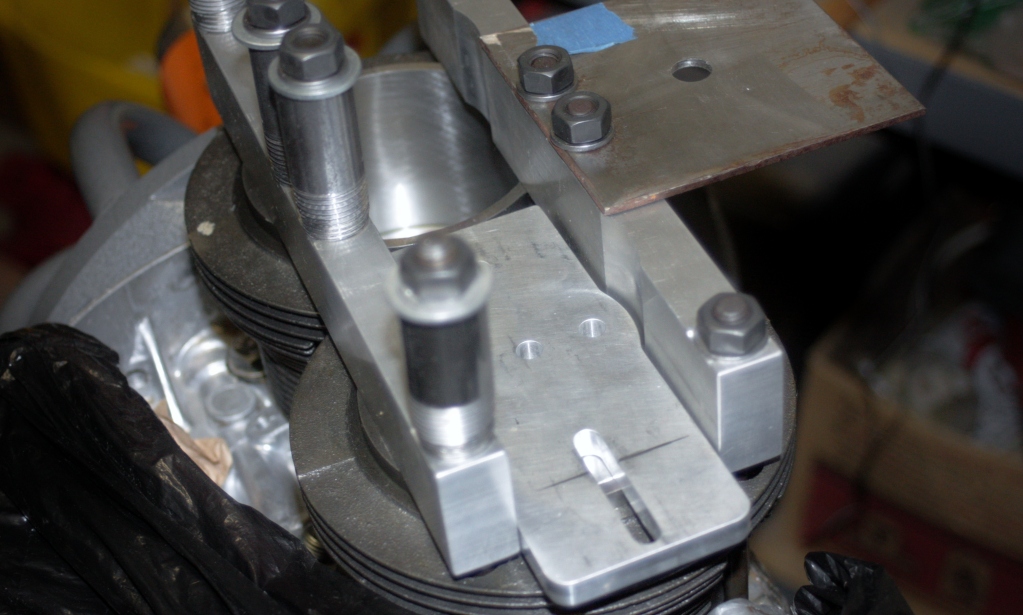
Here is a pic of zeroing the depth gauge on the cylinder edge
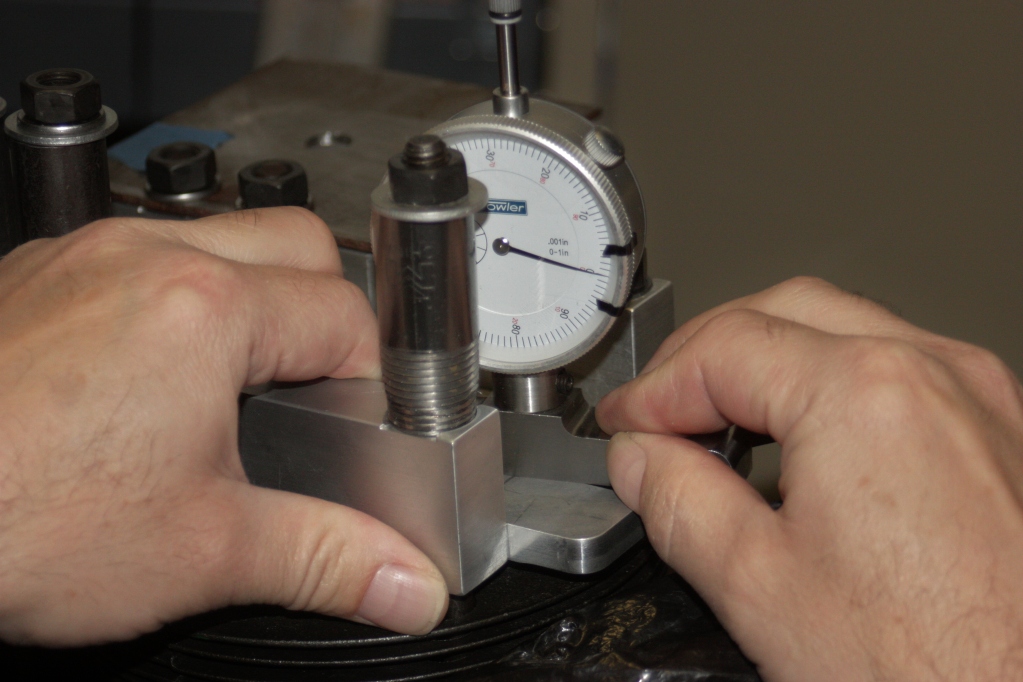
Pic of one side piston:
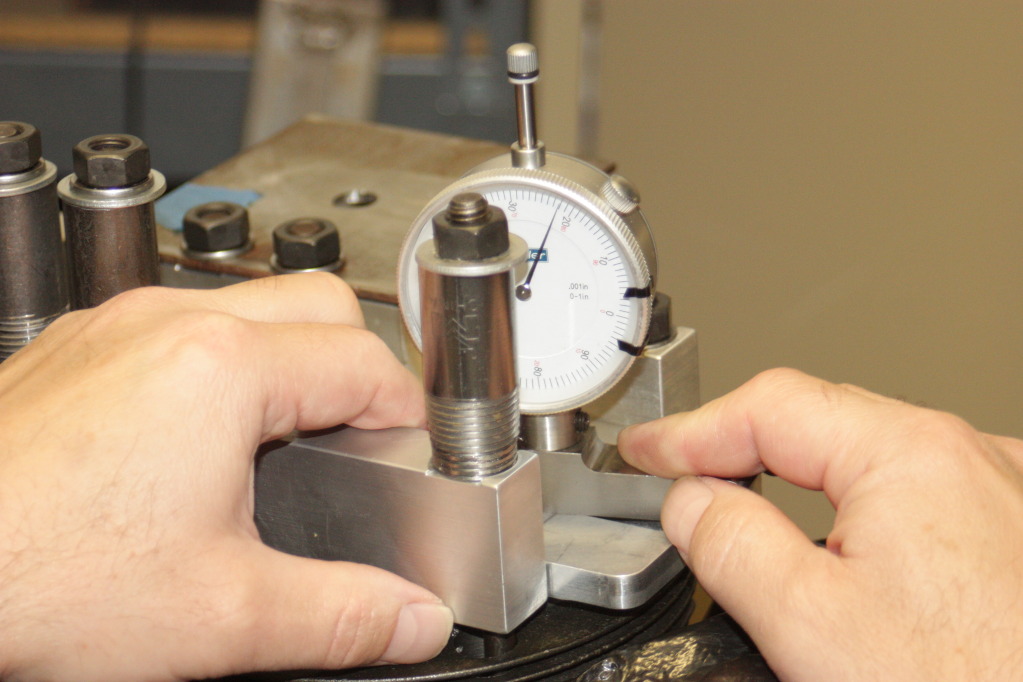
And the other side of the piston:
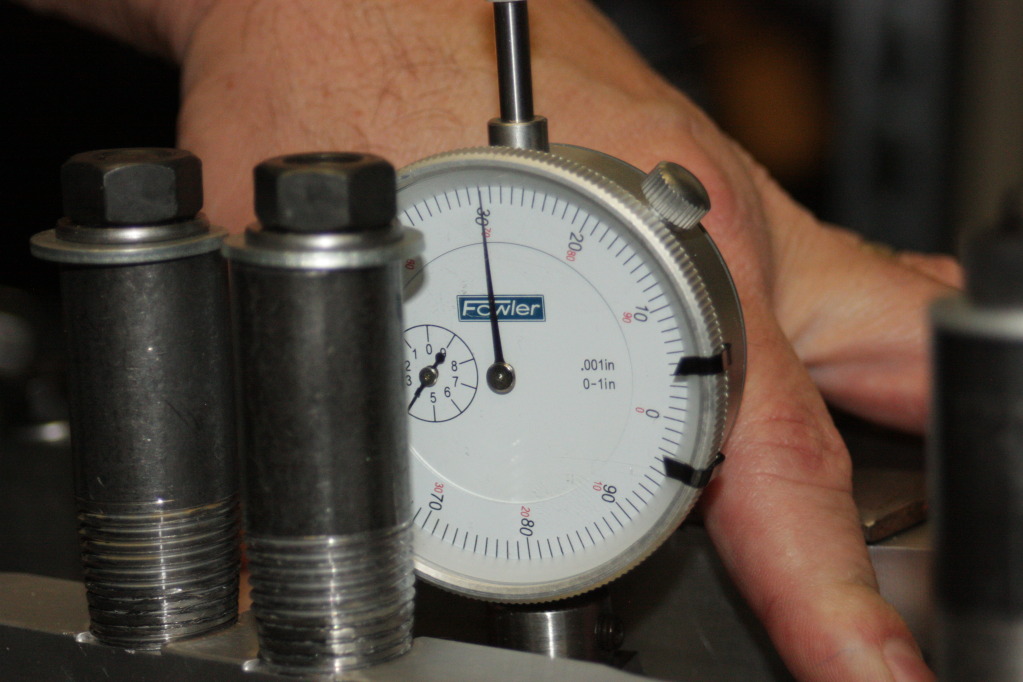
I then flip the AL plate and repeat.
The measurements are dead on repeatable.
One side of that piston measures 0.022 and the other side 0.030.
The other cylinder measures 0.031, & 0.032 which I guess is more normal.
Stu
rick 918-S
Oct 23 2012, 07:03 AM
What happens of you swap cylinders? I would investigate further. If you say the registers are flat. You need to find out if the cylinder issue repetes with a different cylinder in the same hole in the block. I'd start with the cylinders, then check the pistons before moving the rods around. Possibly a machining issue with the wrist pin height. If you start moving rods and pistons as a combo you may miss the issue entirely. I would take it in steps.
Same thing when tuning an engine. You don't want to change several things when running down a miss or idle issue. You more than likely want to work one item at a time until you know what was causing the issue.
yeahmag
Oct 23 2012, 08:28 AM
Flip the plate end for end so the overhang "tang and slot" is over both cylinders. Use the slot to measure any height difference between the two cylinders.
)( <---- Measure both of them on the edges without moving the plate.
This is an idiot check for cylinder length and spigot issues. Let us know what you find.
Valy
Oct 23 2012, 01:29 PM
What is your deck height right now? You should have about 1mm between the cylinder edge and piston.
It looks to me from the picture that the piston is hitting the rails from your measuring adapter. It might be just the picture but...
jmalone
Oct 23 2012, 02:05 PM
Have you measured from the top of the problem piston to the top of the wrist pin bore on each side of the problem piston. Also you can measure the cylynder on each side from the bottom where it seats on the register to the top sealing surface where it seats in the head parallel to the wirst pin . Those measurements should be easy to do and at least you will learn if you have an out of spec cylinder or a piston with a mis-aligned wrist pin bore.
stugray
Oct 27 2012, 12:04 PM
I will do the suggestions above, but for now I repeated all of the measurements with the new depth gauge. (again these measurements are all with no shims under the cylinders)
Cyl #1: Average deck height = 35.0 , "tip" of piston front-to-back = 0.0
Cyl #2: Average deck height = 32.75, "tip" of piston front-to-back = 0.5
Cyl #3: Average deck height = 30.75, "tip" of piston front-to-back = 1.5
Cyl #4: Average deck height = 25.5 , "tip" of piston front-to-back = 8.0
I also measured the "tip" of each piston while at BDC as well as TDC and they were all the same BDC=TDC, so I think that rules out a bent crank
So it appears that there is something wrong with cyl #4. My next experiment will be to just flip rod #4 upside down and repeat the measurements. That should tell me if my #1 theory is correct: that I have a bent rod or an improperly installed wrist pin bushing.
Stu
JoeSharp
Oct 27 2012, 05:00 PM
Pull the crank and lay it on the bench with all the rod ends up and try to push a wrist pen throu all the small the small ends from one to the next. If the rods or the crank is bent it will show. It seems to me my father showed me that some rod from the T-1 tranny fit throu them and showed they were straight.
stugray
Oct 28 2012, 11:18 AM
Joe,
Thanks! but I was hoping to do as many steps as possible without splitting the case again.
I thought about a similar step that I should have done before using the rods.
You could align and clamp all four rods into a vise from the crank end.
Then you should be able to get a wrist pin to slide through all four rods with a minimum of wiggling things a bit ;-) Didnt do that, but maybe next time. This would tell you if all wrist pin bushings are co-linear.
However, does anyone see a problem with my huge range of deck heights?
Cyl #1: = 35.0
Cyl #2: = 32.75
Cyl #3: = 30.75
Cyl #4: = 25.5
I do not see how I can buy shims to make all of those equal while keeping the deck on each head even for mating to the heads.
Stu
wndsrfr
Oct 28 2012, 04:27 PM
QUOTE(stugray @ Oct 28 2012, 09:18 AM)

Joe,
Thanks! but I was hoping to do as many steps as possible without splitting the case again.
I thought about a similar step that I should have done before using the rods.
You could align and clamp all four rods into a vise from the crank end.
Then you should be able to get a wrist pin to slide through all four rods with a minimum of wiggling things a bit ;-) Didnt do that, but maybe next time. This would tell you if all wrist pin bushings are co-linear.
However, does anyone see a problem with my huge range of deck heights?
Cyl #1: = 35.0
Cyl #2: = 32.75
Cyl #3: = 30.75
Cyl #4: = 25.5
I do not see how I can buy shims to make all of those equal while keeping the deck on each head even for mating to the heads.
Stu
Hmmm......#'s 1&3 are high relative to #'s 2&4.....seems like possibly your crank is not centered relative to the registers beneath the cylinders. Is it possible that your engine is composed of two case halves that don't match up? Like if it was put together from two different engines?? Just trying to think out of the box.....
stugray
Oct 28 2012, 09:36 PM
Not sure what this means.
I flipped the #4 Rod and the side to side measurement was nearly Zero (25 & 26.5) but the average was still WAY off of the others.
So the "tip" went away but the average was still messed up.
I then flipped it again and the measurements are the same as before.
WTF!?
I am going to have to think through this one some more....
I have not set my endplay yet, but that should not matter yet...
yeahmag
Oct 28 2012, 10:36 PM
Did you measure the cylinder height differences with the tool yet?
stugray
Oct 29 2012, 07:16 AM
Yes, less than 0.001 between the two.
Stu
stugray
Oct 29 2012, 09:29 PM
Bump!
So the only things I can find say that I need to have the case deck machined, but that doesnt make sense since the tops of the cyls look to be very close (less than 0.001).
Can I have a crank with that much variation?
Mismatched rods?
I want to measure as many things as possible before breaking everything down again.
Stu
yeahmag
Oct 30 2012, 10:00 AM
I would suspect the rods first. You can snake them out without opening the case. It's not fun, but it's doable.
r_towle
Oct 30 2012, 10:27 AM
You need to open up the case and send everything to a machine shop for measurements.
Its not a huge job to open the case again....just take your time and keep track of all the parts.
Get more sealant.
You will sleep better knowing the rods are balanced and the crank has been measured and polished.
Once the case is apart, have them measure the sealing surface where the cylinders meat the case...from a flat surface.
rich
brant
Oct 30 2012, 10:37 AM
I would have a shop check the registers and also for line bore
I believe A LOT of these cases are needing a line bore these days.
brant
Valy
Oct 30 2012, 10:38 AM
Measure the piston travel. If it's as expected (71mm or whatever crank you have) then it's a rod problem. If it's less or more (probably less in your case) then it's a bad crank.
You may also check for play in the bearings. Rotate the crank so the piston is at bottom and then push the piston in the bore. If it goes further down you may have bad bearings, any of them can be the faulty: pin bushing,rod bearings or main bearings.
yeahmag
Oct 30 2012, 10:41 AM
I agree in principal, but there is no reason not to take it one step at a time and pull the rods and have them checked. Personally, I'd tear it down and have the following done:
* Case checked and if necessary line bored
* Deck the registers
* Measure cylinder length
* measure piston crown to pin height
* Blueprint Rods
* Blueprint Crank
But taking out the rods does relegate you to *not* doing any of that, it's just an easily reversible check.
stugray
Oct 30 2012, 02:34 PM
I will go over all of the suggestions above but here are a few comments:
Bearings are all new and stock size.
All journals looked to be in great shape. (measured and inspected).
Entire rotating assy. was already balanced by local machine shop.
Top of cyls measure flat to within .001 with full head torque.
Brand new EMW cyls & flat top pistons.
This is screaming mis-matched rods or bad crank.
I hear that the high perf. crowd have their cranks "indexed" to make sure the stroke is perfectly matched.
With yeahmag's tool I might be able to remove the rods, retorque the cyls and measure to the top of the rod journals at TDC & BTC, but I would be wary of trusting that measurement unless way off....
I have another set of rods, but not sure if they are 1.8L or 2.0L (I have two engines, so spare parts could go with either after years of storage).
I think I will give EMW a call too.
Stu
r_towle
Oct 30 2012, 02:37 PM
Crank was balanced at a shop? then its straight.
Rods balanced and they are stock rods? those should be fine.
Maybe one of the dowel pins was not lined up, but otherwise I would pull all the cylinders and pistons and measure those very carefully.
Then if those check out...and all pin heights are correct...
It must be the case.
rich
yeahmag
Oct 30 2012, 02:40 PM
Actually, the rods can be in balance but different lengths. Typically resizing the large end for a new bearing at the machine shop involves cutting some material off the cap and then honing to round again. You can end up with rods of different lengths after this is done a few times.
This is a "lo-fi" version of our main content. To view the full version with more information, formatting and images, please
click here.





